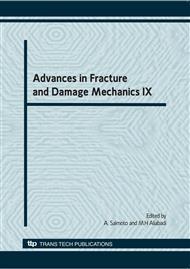p.729
p.733
p.737
p.741
p.745
p.749
p.753
p.757
p.761
Effect of Humidity on Fatigue Strength of Age-Hardened Al Alloy under Rotating Bending
Abstract:
In order to investigate the effect of humidity on fatigue strength of an extruded and age-hardened Al alloy 7075-T6, rotating bending fatigue tests were carried out using plain specimens in environments of controlled relative humidity of 25%, 50%, 75% and 85% and distilled water. The cross section of the alloy has a marked texture of (111) plane. Although fatigue strength was decreased by high humidity, the decrease by high humidity was very small when the humidity was lower than about 60% -70% and fatigue strength was largely decreased over the humidity. Both of initiation and propagation of a crack were accelerated by high humidity. In high humidity, a crack propagated in a shear mode macroscopically and it was ductile in company with many glide planes and voids microscopically. That is, the propagation was not a tensile mode with brittle facets even in water. The shear mode propagation inclined about 35° to the extruded direction and fracture surface was (100) plane, meaning that the shear mode propagation of a crack was mainly caused by the marked texture of the alloy. The propagation mode of a crack was affected by not only environment but also stress level.
Info:
Periodical:
Pages:
745-748
Citation:
Online since:
November 2010
Authors:
Price:
Сopyright:
© 2011 Trans Tech Publications Ltd. All Rights Reserved
Share:
Citation:


